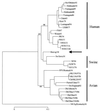Characterization of the 1918 "Spanish" influenza virus neuraminidase gene
- PMID: 10823895
- PMCID: PMC18739
- DOI: 10.1073/pnas.100140097
Characterization of the 1918 "Spanish" influenza virus neuraminidase gene
Abstract
The "Spanish" influenza pandemic of 1918 was characterized by exceptionally high mortality, especially among young adults. The surface proteins of influenza viruses, hemagglutinin and neuraminidase, play important roles in virulence, host specificity, and the human immune response. The complete coding sequence of hemagglutinin was reported last year. This laboratory has now determined the complete coding sequence of the neuraminidase gene of the 1918 virus. Influenza RNA fragments were isolated from lung tissue of three victims of the 1918 flu; complete sequence was generated from A/Brevig Mission/1/18, with confirmatory sequencing carried out on A/South Carolina/1/18 and A/New York/1/18. The 1918 neuraminidase gene sequence was compared with other N1 subtype neuraminidase genes, including 9 N1 strains newly sequenced for this study. The 1918 neuraminidase shares many sequence and structural characteristics with avian strains, including the conserved active site, wild-type stalk length, glycosylation sites, and antigenic sites. Phylogenetically, the 1918 neuraminidase gene appears to be intermediate between mammals and birds, suggesting that it was introduced into mammals just before the 1918 pandemic.
Figures



Similar articles
-
H9N2 Influenza Virus Infections in Human Cells Require a Balance between Neuraminidase Sialidase Activity and Hemagglutinin Receptor Affinity.J Virol. 2020 Aug 31;94(18):e01210-20. doi: 10.1128/JVI.01210-20. Print 2020 Aug 31. J Virol. 2020. PMID: 32641475 Free PMC article.
-
Antiviral susceptibility of avian and swine influenza virus of the N1 neuraminidase subtype.J Virol. 2010 Oct;84(19):9800-9. doi: 10.1128/JVI.00296-10. Epub 2010 Jul 21. J Virol. 2010. PMID: 20660186 Free PMC article.
-
Characterization of the surface proteins of influenza A (H5N1) viruses isolated from humans in 1997-1998.Virology. 1999 Feb 1;254(1):115-23. doi: 10.1006/viro.1998.9529. Virology. 1999. PMID: 9927579
-
Changes in the haemagglutinin and the neuraminidase genes prior to the emergence of highly pathogenic H7N1 avian influenza viruses in Italy.Arch Virol. 2001;146(5):963-73. doi: 10.1007/s007050170128. Arch Virol. 2001. PMID: 11448033
-
Integrating historical, clinical and molecular genetic data in order to explain the origin and virulence of the 1918 Spanish influenza virus.Philos Trans R Soc Lond B Biol Sci. 2001 Dec 29;356(1416):1829-39. doi: 10.1098/rstb.2001.1020. Philos Trans R Soc Lond B Biol Sci. 2001. PMID: 11779381 Free PMC article. Review.
Cited by
-
Existing antivirals are effective against influenza viruses with genes from the 1918 pandemic virus.Proc Natl Acad Sci U S A. 2002 Oct 15;99(21):13849-54. doi: 10.1073/pnas.212519699. Epub 2002 Oct 4. Proc Natl Acad Sci U S A. 2002. PMID: 12368467 Free PMC article.
-
Using classical population genetics tools with heterochroneous data: time matters!PLoS One. 2009;4(5):e5541. doi: 10.1371/journal.pone.0005541. Epub 2009 May 14. PLoS One. 2009. PMID: 19440242 Free PMC article.
-
The matrix segment of the "Spanish flu" virus originated from intragenic recombination between avian and human influenza A viruses.Transbound Emerg Dis. 2019 Sep;66(5):2188-2195. doi: 10.1111/tbed.13282. Epub 2019 Jul 15. Transbound Emerg Dis. 2019. PMID: 31241237 Free PMC article.
-
Structural characterization of the 1918 influenza virus H1N1 neuraminidase.J Virol. 2008 Nov;82(21):10493-501. doi: 10.1128/JVI.00959-08. Epub 2008 Aug 20. J Virol. 2008. PMID: 18715929 Free PMC article.
-
Characterization of the noncoding regions of the 1918 influenza A H1N1 virus.J Virol. 2014 Feb;88(3):1815-8. doi: 10.1128/JVI.03098-13. Epub 2013 Nov 13. J Virol. 2014. PMID: 24227852 Free PMC article.
References
Publication types
MeSH terms
Substances
Associated data
- Actions
- Actions
- Actions
- Actions
- Actions
- Actions
- Actions
- Actions
- Actions
- Actions
LinkOut - more resources
Full Text Sources
Other Literature Sources

